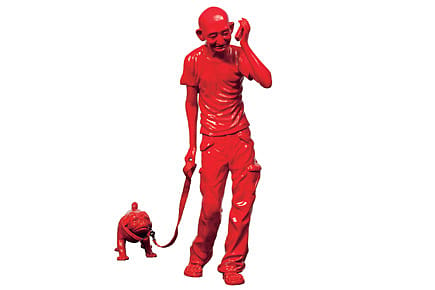Gandhi, the Untouchable

Artist J Nandakumar had his show cancelled because he dared to show Gandhi trampling on Dalit rights. He fights on
The image of the Father of the Nation has acquired an iconic significance with sacrosanct connotations. And any artist who chooses to move away from this iconic formula ventures into perilous territory. This was revealed in the recently banned exhibition of the works of artist J Nandakumar at the Nehru Centre Gallery, Mumbai. "For the first three days, the exhibition carried on without any disturbance, when all of a sudden, things took a different turn," says this Aurangabad-based artist.
Known for depicting exploitative tendencies in society, Nandakumar's works examine societal mores with a discerning brush. Thus it is that in the show, he had included his work Blind Faith, taking as his theme a practice of worship prevalent in parts of Karnataka, wherein a nude male prostrates himself before the goddess as part of a ritual observance. "Someone viewed my exhibition and warned the organisers that unless they removed the objectionable painting, he would organise a protest morcha. The Nehru Centre, giving in to the pressure, requested me to remove the painting. When I tried explaining my point of view, that my art is a reflection of my personal idea about things in society, they became even more insistent."
2026 New Year Issue
Essays by Shashi Tharoor, Sumana Roy, Ram Madhav, Swapan Dasgupta, Carlo Pizzati, Manjari Chaturvedi, TCA Raghavan, Vinita Dawra Nangia, Rami Niranjan Desai, Shylashri Shankar, Roderick Matthews, Suvir Saran
Things got further vexed when the organisers came back with yet another corollary, saying that a painting on Gandhi, Gandhi (After Pune Karar), should also be removed. In this particular painting, says YS Alone of the School of Arts and Aesthetics, Jawaharlal Nehru University, New Delhi, "Gandhiji's stick is converted into a trident at the upper end, whereas the lower end is a lance piercing the body of a Dalit, signifying how he killed the political rights of Dalits in the country." He asserts that Nandakumar is striking at the core of Brahminical cultural nationalism.
In the catalogue to the exhibition, Alone states that Nandakumar 'prefers to challenge the conventional notion of [the] image of Gandhi not only as the Father of the Nation, but also makes a daring attempt to deconstruct the image of Gandhi through his personal understanding that has a legacy of Dr Ambedkar.'
For the artist, the inspiration for this painting came about after reading details of the Poona Pact, a 1932 agreement between Ambedkar and leaders of upper caste Hindus over the former's demand for a separate electorate for 'untouchables'. Ambedkar is said to have agreed to this compromise solution only because of the tremendous pressure exerted by Gandhi's vehement opposition to the separate electorate. Believing it would disintegrate Hindu society, he had gone on an indefinite hunger strike in protest.
Says the artist, "On reading the Pune Karar, I felt that Gandhiji was no longer an embodiment of peace, as I had earlier thought him to be. This led me to express my ideas in the form of a painting. So when the organisers asked me to withdraw the painting from the show, I gave them two options—cancel my exhibition altogether, or let it continue in its present way. The outcome was inevitable."
But the incident has been no dampener for this free-thinking and expressive artist. As he points out, the fallout of this image has laid the ground for a rearing form of protest. "In my home town of Aurangabad, I have found several supporters of my point of view, and they have joined hands with me to condemn the withdrawal of an exhibition on a single telephone call received by the authorities. In my own capacity, I will continue to do a series of paintings on the manner in which I conceive
the Gandhian image that has taken root in my mind, where Gandhiji has ceased to be the apostle of peace that I had earlier nurtured."
